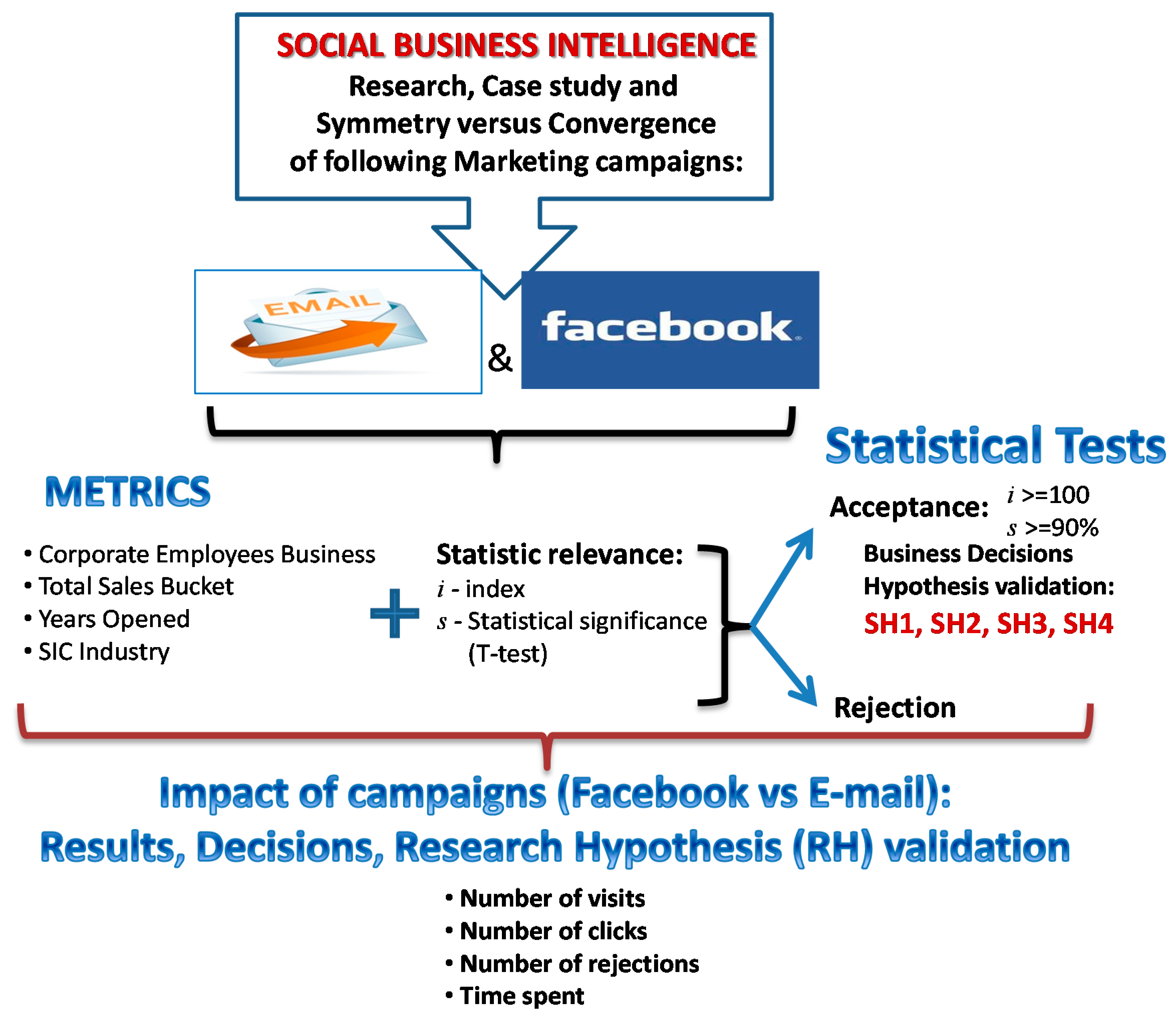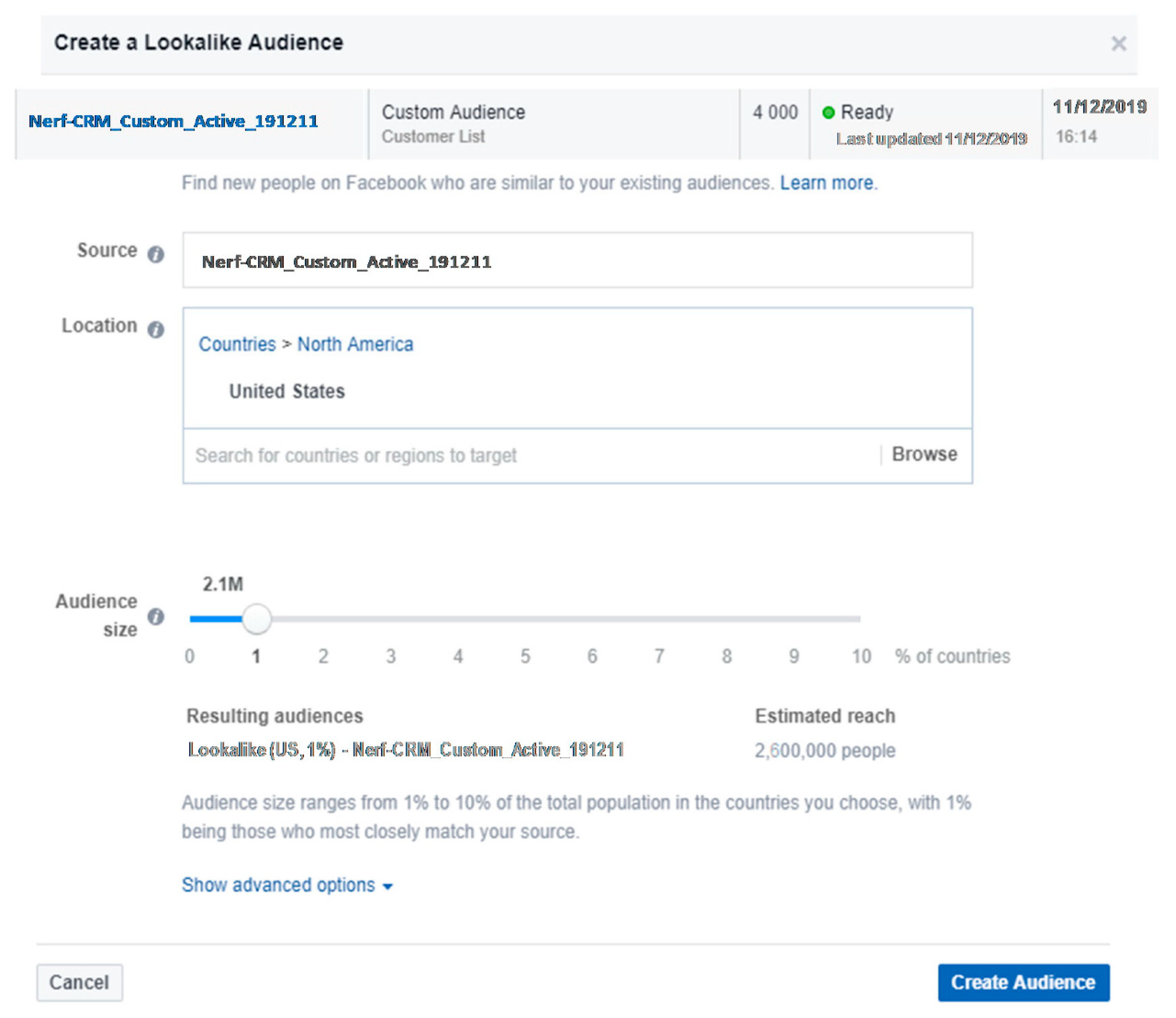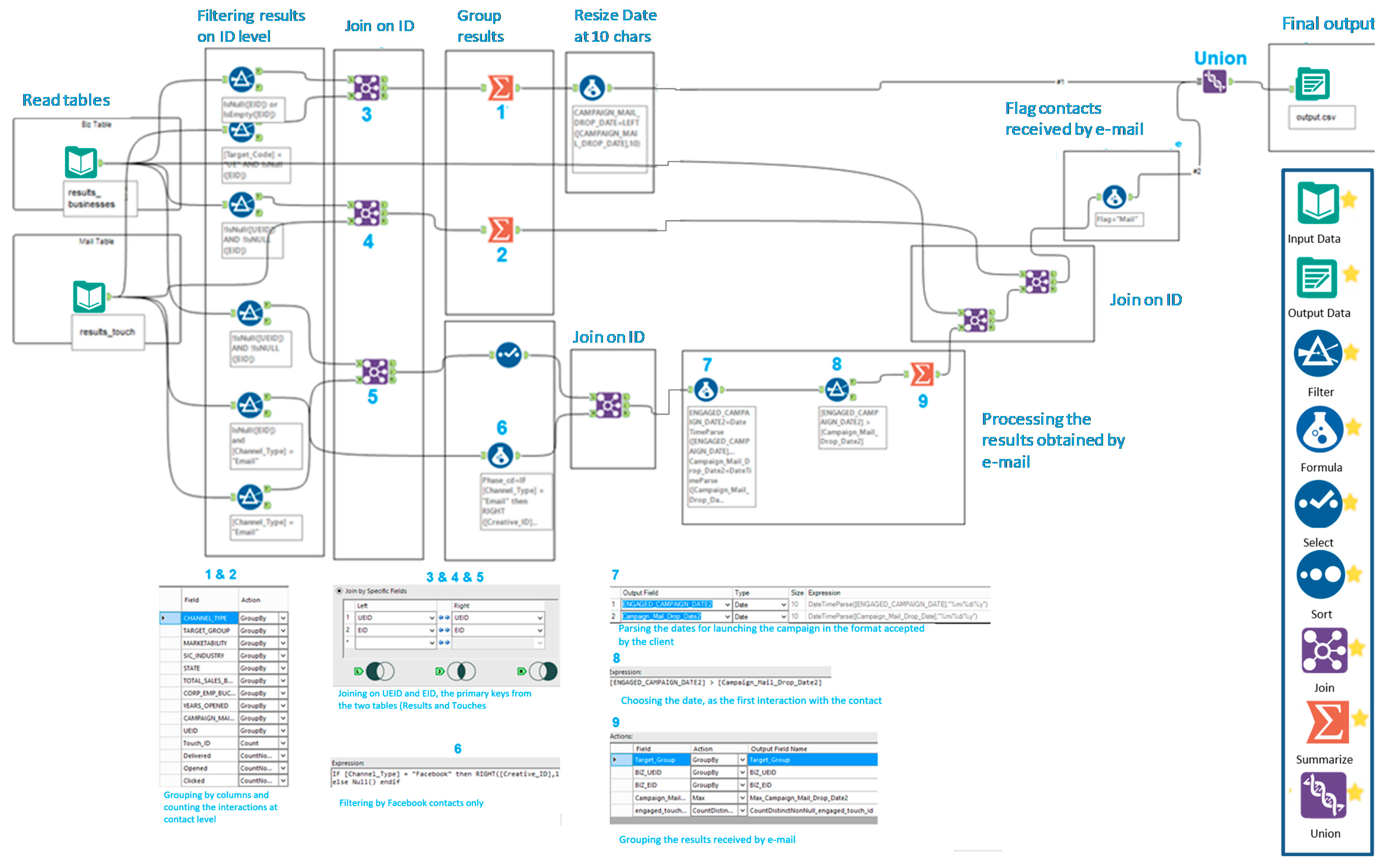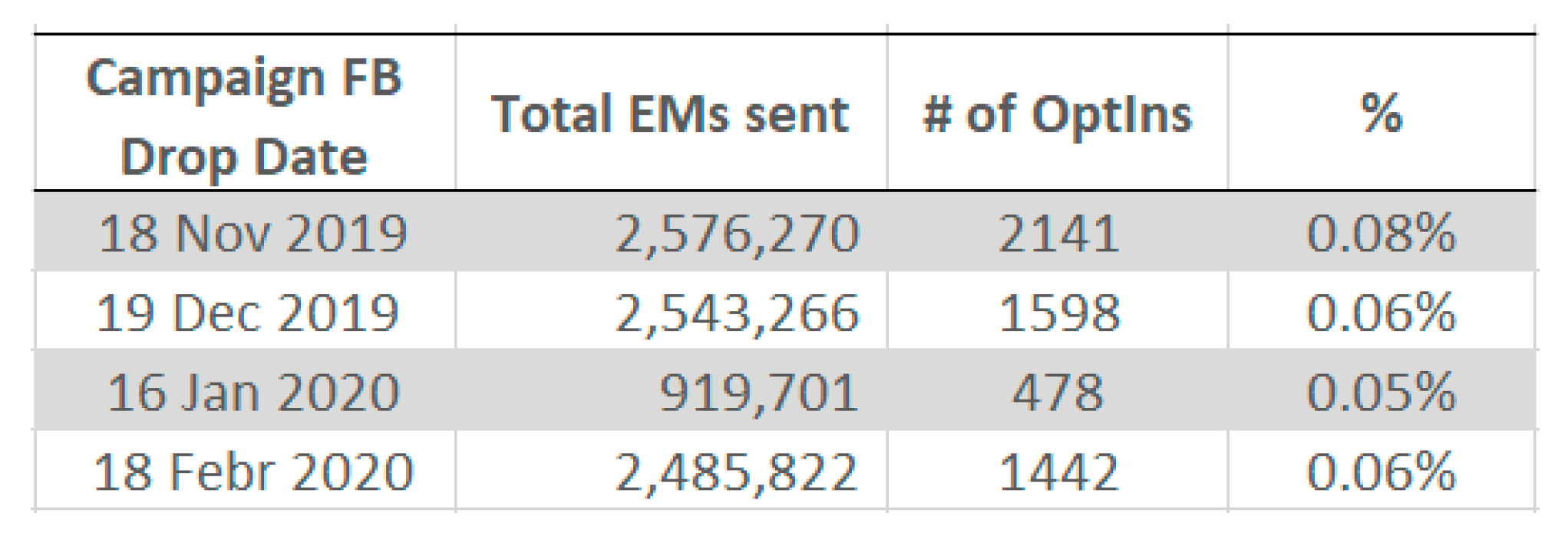Social Media and E-mail Marketing Campaigns: Symmetry versus Convergence
Abstract
:1. Introduction
1.1. Social Data and Social Media Analytics
1.2. E-mail Marketing Campaigns
1.3. Social Business Intelligence
2. Materials and Methods
2.1. Research Objective
2.2. Research Methodology
- Facebook Manager—to develop client portfolio and launch the online campaign;
- Oracle 12c—to develop the database comprising all information stored by clients on SM (social data);
- Alteryx 10.5—to transform and calculate each indicator needed for the analysis;
- Tableau 10—to view real time data in the database.
- Direct: potential clients who found the campaign directly without being redirected by other web sites;
- Recommendation: potential clients who found the campaign through a website or application, not by using any websites or search engine;
- Organic: potential clients found the campaign through such search engines as Google;
- E-mail: potential clients found the campaign through a contact email on any communication channel;
- Social: potential clients found the campaign website by searching social media information about the company.
- Web content: the study used to see how efficient the layout of the campaign’s web page is, and which actions visitors made on specific sections of the web page;
- Individual visitors: this metrics measuring if a new visitor visits the page, the amount of time spent, and whether it ever returns on page;
- Click rate: mostly it includes the page accessing clicks;
- Rejection rate: this metrics includes data compilation related to leaving the campaign page by the visitor without doing any other action;
- Mail opening rate: the rate calculates mail openings compared to all sent emails;
- Opting rate: it shows the success of the campaign in attracting people interested in the promotion campaign;
- Number of visitors on the campaign page.
2.2.1. Data Collection
2.2.2. Design Instrument
3. Results
3.1. Metrics Analysis for the Facebook Campaign
3.2. Metrics Analysis for the Email Campaign
4. Discussion
- R1: in case of Corp Emp Buss metrics for the SM campaign, two of the tested cases have been accepted for companies with 40–49 and 50–100 employees. As for the email campaign, two of the tested cases have been validated for companies with 10–19 and 50–100 employees.
- SH1: both campaigns had statistically significant results, and in case of the Facebook campaign, companies with higher number of employees (40–49 and 50–100 employees) were the most receptive to marketing campaigns. The companies that responded to the email campaign are quite close to the extremes, with an average number of (10–19) and (50–100) employees (included in the sample). An analysis of statistical significance shows us that SM compared to email resulted in the highest degree of confidence. The results show that the two campaigns are different, the companies behaving differently in SM versus email campaigns, therefore, it could be stated that the SH1 hypothesis has been validated.
- D1: business decision is based on the fact that both campaigns (SM and email) had a good score for companies with 50–100 employees, that is why, to optimize the results of a future campaign, the following should be applied:
- Combined (SM + e-mail), the target group should include companies with 50–100 employee;
- Only on Facebook, the target group should include companies with 40–49 and 50–100 employee;
- Only by email, the target group should include companies with 10–19 and 50–100 employee.
- R2: for the segment of analyzed contacts by total sales bucket, there were three statistically validated cases for the Facebook campaign and two cases for the email campaign. Thus, the SM campaign attracted the attention of companies with values of total sales bucket situated between USD $50,000 and $100,000; $250,000 and $500,000; and $500,000 and $1,000,000, at the most valuable extreme of the category. The email campaign was more attractive for companies with lower (USD $5000–$50,000) and medium (USD $250,000–$500,000) total sales bucket.
- SH2: both campaigns produced valuable results for future campaigns and we observe different behavior of companies grouped by total sales bucket. Therefore, companies interested in the SM campaign have high values of total sales bucket metrics, while companies attracted by the email campaign display low and medium value of this metrics. It could be stated that the hypothesis SH2 has been validated as the companies analyzed using the total sales bucket metrics reacted differently to the two analyzed campaigns.
- D2: target market configuration should take into account the following scenarios for a future marketing campaign:
- Combined campaign (SM + e-mail), the target group should include companies with total sales bucket of USD $250,000–$500,000;
- SM campaign, the target group should include companies with total sales bucket of USD $50,000–$100,000; $250,000–$500,000; and $500,000–$1,000,000;
- Email campaign, the target group should include companies with total sales bucket of USD $5000–$50,000 and $250,000–$500,000.
- R3: for the contacts segmented by SIC Industry, the results of SM campaign have validated three totally different industries for the two marketing campaigns. Therefore, the SM campaign attracted companies from services, wholesale trade and manufacturing, while the e-mail marketing campaign was fruitful for the companies from construction and retail trade industries.
- SH3: the results show that companies targeted by these two types of marketing campaigns (grouped by SIC industry) have different preferences and behavior. So, the SH3 hypothesis has been validated.
- D3: for a future marketing campaign scenario, the ideal client could be found in these SIC Industry categories:
- Construction, services, retail trade, wholesale trade, and manufacturing for a combined campaign (SM and e-mail);
- Services, wholesale trade and manufacturing for a SM campaign;
- Construction and retail trade for an email campaign.
- R4: the segment of contacts grouped by years opened resulted in a very good segmentation: relatively newly opened companies respond mainly to SM campaigns, while older companies are more attracted to email campaigns.
- SH4: the results enable us to validate the hypothesis stating that companies grouped by years opened responded differently to the two market campaigns (SM vs. e-mail). Therefore, we note that newly opened companies (4–5 years, 6–10 years, and 11–20 years) prefer Facebook campaigns, while significantly older companies (21–49 years and 50–100 years) prefer email-marketing campaigns.
- D4: For a future marketing campaign, to get optimal results, the group of targeted companies grouped by years opened should apply the following scenarios:
- Combined campaign (SM + e-mail) should address companies with years opened of 4–5, 6–10, 11–20, 21–49, and 50–100 years;
- SM campaign should address companies with years opened of 4–5, 6–10, and 11–20 years;
- Email campaign should address companies with years opened of 21–49 and 50–100 years.
5. Conclusions
Author Contributions
Funding
Conflicts of Interest
References
- Chen, H.; Chiang, R.H.L.; Storey, V.C. Business intelligence and analytics: From big data to big impact. MIS Q. 2012, 36, 1165–1188. [Google Scholar] [CrossRef]
- Rainey, D.L.; Robert, J.A. The Pursuit of Sustainability: Creating Business Value through Strategic Leadership, Holistic Perspectives, and Exceptional Performance; Information Age Publishing—IAP: Charlotte, NC, USA, 2015. [Google Scholar]
- Chiaramonte, L.; Dreassi, A.; Paltrinieri, A.; Piserà, S. Sustainability Practices and Stability in the Insurance Industry. Sustainability 2020, 12, 5530. [Google Scholar] [CrossRef]
- Sustainable Marketing Lessons, Sustainability Management School (SUMAS), October 2018. Available online: https://sumas.ch/4-sustainable-marketing-lessons/ (accessed on 8 June 2020).
- Farzindar, A.A.; Inkpen, D. Natural Language Processing for Social Media. Synth. Lect. Hum. Lang. Technol. 2020, 13, 1–219. [Google Scholar] [CrossRef]
- Zeng, D.; Chen, H.; Lusch, R.; Li, S.-H. Social media analytics and intelligence. IEEE Intell. Syst. 2010, 25, 13–16. [Google Scholar] [CrossRef]
- Liere-Netheler, K.; Gilhaus, L.; Vogelsang, K.; Hoppe, U. A Literature Review on Application Areas of Social Media Analytics. In BIS 2019: Business Information Systems; Lecture Notes in Business Information Processing; Abramowicz, W., Corchuelo, R., Eds.; Springer: Berlin/Heidelberg, Germany, 2019; Volume 354. [Google Scholar]
- Georgescu, M.R.; Bogoslov, I.A. Importance and Opportunities of Sentiment Analysis in Developing E-Learning Systems through Social Media. In DIEM: Dubrovnik International Economic Meeting; Sveučilište u Dubrovniku: Dubrovnik, Croatia, 2019; Volume 4, pp. 83–93. [Google Scholar]
- Pang, B.; Lee, L. Opinion mining and sentiment analysis. Comput. Linguist. 2009, 35, 311–312. [Google Scholar]
- Iglesias, C.A.; Moreno, A. Sentiment Analysis for Social Media. Appl. Sci. 2019, 9, 5037. [Google Scholar] [CrossRef] [Green Version]
- Patel, R.; Passi, K. Sentiment Analysis on Twitter Data of World Cup Soccer Tournament Using Machine Learning. IoT 2020, 1, 14. [Google Scholar] [CrossRef]
- Sánchez-Rada, J.F.; Iglesias, C.A. Social context in sentiment analysis: Formal definition, overview of current trends and framework for comparison. Inf. Fusion 2019, 52, 344–356. [Google Scholar] [CrossRef]
- Ha, H.; Han, H.; Mun, S.; Bae, S.; Lee, J.; Lee, K. An Improved Study of Multilevel Semantic Network Visualization for Analyzing Sentiment Word of Movie Review Data. Appl. Sci. 2019, 9, 2419. [Google Scholar] [CrossRef] [Green Version]
- Kim, H.; Jeong, Y.-S. Sentiment Classification Using Convolutional Neural Networks. Appl. Sci. 2019, 9, 2347. [Google Scholar] [CrossRef] [Green Version]
- Mao, X.; Chang, S.; Shi, J.; Li, F.; Shi, R. Sentiment-Aware Word Embedding for Emotion Classification. Appl. Sci. 2019, 9, 1334. [Google Scholar] [CrossRef] [Green Version]
- Jabreel, M.; Moreno, A. A Deep Learning-Based Approach for Multi-Label Emotion Classification in Tweets. Appl. Sci. 2019, 9, 1123. [Google Scholar] [CrossRef] [Green Version]
- Sulikowski, P.; Zdziebko, T. Deep Learning-Enhanced Framework for Performance Evaluation of a Recommending Interface with Varied Recommendation Position and Intensity Based on Eye-Tracking Equipment Data Processing. Electronics 2020, 9, 266. [Google Scholar] [CrossRef] [Green Version]
- Bock, J.R.; Maewal, A. Adversarial Learning for Product Recommendation. AI 2020, 1, 25. [Google Scholar] [CrossRef]
- Sulikowski, P.; Zdziebko, T.; Turzyński, D. Modeling online user product interest for recommender systems and ergonomics studies. Concurr. Comput. Pract. Exp. 2019, 31, e4301. [Google Scholar] [CrossRef]
- Sulikowski, P.; Zdziebko, T.; Turzyński, D.; Kańtoch, E. Human-website interaction monitoring in recommender systems. Procedia Comput. Sci. 2018, 126, 1587–1596. [Google Scholar] [CrossRef]
- Mattiev, J.; Kavsek, B. Coverage-Based Classification Using Association Rule Mining. Appl. Sci. 2020, 10, 7013. [Google Scholar] [CrossRef]
- Ampornphan, P.; Tongngam, S. Exploring Technology Influencers from Patent Data Using Association Rule Mining and Social Network Analysis. Information 2020, 11, 333. [Google Scholar] [CrossRef]
- Adomavicius, G.; Tuzhilin, A. Toward the next generation of recommender systems: A survey of the state-of-the-art and possible extensions. IEEE Trans. Knowl. Data Eng. 2005, 17, 734–749. [Google Scholar] [CrossRef]
- Fan, W.; Gordon, M.D. The power of social media analytics. Commun. ACM 2014, 57, 74–81. [Google Scholar] [CrossRef]
- Anderson, J.C.; Narus, J.A.; Narayandas, D. Business Market Management: Understanding, Creating and Delivering Value; Pearson Education: London, UK, 2004. [Google Scholar]
- Rathore, A.; Kar, A.; Ilavarasan, V. Social Media Analytics: Literature Review and Directions for Future Research. Decis. Anal. 2017, 14, 229–249. [Google Scholar] [CrossRef]
- Ojagh, S.; Malek, M.R.; Saeedi, S. A Social–Aware Recommender System Based on User’s Personal Smart Devices. ISPRS Int. J. Geo Inf. 2020, 9, 519. [Google Scholar] [CrossRef]
- Chen, H.; Chiang, R.H.; Storey, V.C. Business intelligence research. MIS Q. 2010, 34, 201–203. [Google Scholar]
- Garcia-Morales, V.J.; Martín-Rojas, R.; Lardón-López, M.E. Influence of social media technologies on organizational performance through knowledge and innovation. Balt. J. Manag. 2018, 13, 345–367. [Google Scholar] [CrossRef]
- Martín-Rojas, R.; García-Morales, V.J.; Garrido-Moreno, A.; Salmador-Sanchez, M.P. Social Media Use and the Challenge of Complexity: Evidence from the Technology Sector. J. Bus. Res. 2020, in press. [Google Scholar] [CrossRef]
- Shen, C.W.; Luong, T.H.; Ho, J.T.; Djailani, I. Social media marketing of IT service companies: Analysis using a concept-linking mining approach. Ind. Market. Manag. 2020, 90, 593–604. [Google Scholar] [CrossRef]
- Kopanakis, Significance of Social Media Analytics for Insurance Businesses. 2020. Available online: https://www.mentionlytics.com/blog/social-media-analytics-for-insurance-businesses/ (accessed on 12 August 2020).
- Ahrholdt, D.; Greve, G.; Hopf, G. Online-Marketing-Intelligence; Springer Books: New York, NY, USA, 2019; p. 145. [Google Scholar] [CrossRef]
- Hudák, M.; Kianičková, E.; Madleňák, R. The Importance of E-mail Marketing in E-commerce. Procedia Eng. 2017, 192, 342–347. [Google Scholar] [CrossRef]
- Qabbaah, H.; Sammour, G.; Vanhoof, K.; Voronin, A.; Ziatdinov, Y.; Aslanyan, L.; Sahakyan, H.; Rayan, Z.; Alfonse, M.; Salem, A.B.M.; et al. Decision Tree Analysis to Improve e-mail Marketing Campaigns. Int. J. Inf. Theor. Appl. 2019, 26, 3–36. [Google Scholar]
- Mouro, C.; Alturas, B. Factors influencing the consumer to accept advertising by e-mail. In Proceedings of the 11th Iberian Conference on Information Systems and Technologies (CISTI), Las Palmas, Spain, 15–18 June 2016; pp. 1–6. [Google Scholar] [CrossRef]
- Sandage, E. Best Practices in E-Mail Marketing. Membersh. Manag. Rep. 2017, 13, 6. [Google Scholar] [CrossRef]
- The Radicati Group, Inc. (Technology Market Research Firm), Email Market, 2020–2024 Executive Summary, 27 April 2020. Available online: https://www.radicati.com/?p=16885 (accessed on 10 August 2020).
- Floričić, T. Digital Tourism Promotion and E-mail Marketing. In Innovation Management, Entrepreneurship and Sustainability; IMES 2018; Vysoká škola ekonomická v Praze: Prague, Czech Republic, 2018; pp. 317–331. [Google Scholar]
- Fotache, M.; Dumitriu, F.; Greavu-Serban, V. Differences in Information System Skills of Offshoring Source Markets and Destination Markets. Transform. Bus. Econ. 2016, 15, 478–799. [Google Scholar]
- Wadia, R. Effectiveness of health marketing campaigns. Br. Dent. J. 2020, 228, 595. [Google Scholar] [CrossRef] [PubMed]
- Bradley, J.; Gardner, G.; Rowland, M.K.; Fay, M.; Mann, K.; Holmes, R.; Foster, E.; Exley, C.; Don Bosco, A.; Hugueniot, O.; et al. Impact of a health marketing campaign on sugars intake by children aged 5–11 years and parental views on reducing children’s consumption. BMC Public Health 2020, 20, 1–11. [Google Scholar] [CrossRef] [PubMed] [Green Version]
- Mathews, R.; Buys, D. Healthy Eating Social Marketing Campaigns: A Systematic Review of the Literature. J. Acad. Nutr. Diet. 2020, 120, A81. [Google Scholar] [CrossRef]
- Tarczydło, B.; Miłoń, J. E-Marketing Campaign for a University. Case Study. Mark. Sci. Res. Organ. 2019, 31, 151–172. [Google Scholar] [CrossRef] [Green Version]
- Grubor, A.; Đokić, N.; Milićević, N. The use of e-mail marketing in accordance with permission marketing approach in promotion of a study program. Strateg. Manag. 2018, 23, 26–31. [Google Scholar] [CrossRef]
- Belgiu (Curea), C.-G.; Constantin, I. Political Marketing Campaign. Logos Universality Mentality Education Novelty; Section: Political Sciences and European Studies; Editura Lumen: Iasi, Romania, 2017; Volume IV, pp. 25–32. [Google Scholar] [CrossRef]
- Lanza-Cruz, I.; Berlanga, R.; Aramburu, M.J. Modeling Analytical Streams for Social Business Intelligence. Informatics 2018, 5, 33. [Google Scholar] [CrossRef] [Green Version]
- Target Market. Available online: https://www.investopedia.com/terms/t/target-market.asp (accessed on 11 August 2020).
- Gioti, H.; Stavros, T.P.; Panayiotou, N. Social business intelligence: Review and research directions. J. Intell. Stud. Bus. 2018, 8, 23–42. [Google Scholar] [CrossRef] [Green Version]
- Berlanga, R.; García-Moya, L.; Nebot, V.; Aramburu, M.; Sanz, I.; Llidó, D. SLOD-BI: An Open Data Infrastructure for Enabling Social Business Intelligence. Int. J. Data Wareh. Data Min. 2015, 11, 1–28. [Google Scholar] [CrossRef] [Green Version]
- Francia, M.; Gallinucci, E.; Golfarelli, M.; Rizzi, S. Social Business Intelligence in Action. In Proceedings of the Advanced Information Systems Engineering: 28th International Conference CAiSE, Ljubljana, Slovenia, 13–17 June 2016; pp. 33–48. [Google Scholar]
- Berlanga, R.; Lanza-Cruz, I.; Aramburu, M.J. Quality Indicators for Social Business Intelligence. In Proceedings of the Sixth International Conference on Social Networks Analysis, Management and Security (SNAMS) 2019, Granada, Spain, 22–25 October 2019; pp. 229–236. [Google Scholar] [CrossRef]
- Sun, X.; Zhang, C.; Li, G.; Sun, D.; Ren, F.; Zomaya, A.; Ranjan, R. Detecting users’ anomalous emotion using social media for business intelligence. J. Comput. Sci. 2018, 25, 193–200. [Google Scholar] [CrossRef]
- Statista, Social Network Advertising Spending in the United States from 2016 to 2020 Report. 2019, USA. Available online: https://www.statista.com/statistics/736971/social-media-ad-spend-usa/ (accessed on 11 June 2020).
- King, C. Social Media Marketing Strategy in 2020, HubSpot Academy 2020. Available online: https://bit.ly/33B8CUB (accessed on 10 August 2020).
- HubSpot. Available online: https://www.hubspot.com/marketing-statistics (accessed on 8 August 2020).
- Jewell, N. The analytics lifecycle and the age of innovation. Netw. Secur. 2019, 2019, 8–11. [Google Scholar] [CrossRef]
- Khirfan, L.; Mohtat, N.; Peck, M. A systematic literature review and content analysis combination to “shed some light” on stream daylighting (Deculverting). Water Secur. 2020, 10, 100067. [Google Scholar] [CrossRef]
- Lee-Post, A.; Pakath, R. Numerical, secondary Big Data quality issues, quality threshold establishment, & guidelines for journal policy development. Decis. Support Syst. 2019, 126, 113135. [Google Scholar] [CrossRef]
- Loft, L.H.; Pedersen, E.A.; Jacobsen, S.U.; Søborg, B.; Bigaard, J. Using Facebook to increase coverage of HPV vaccination among Danish girls: An assessment of a Danish social media campaign. Vaccine 2020, 38, 4901–4908. [Google Scholar] [CrossRef] [PubMed]
- Dalenberg, D.J. Preventing discrimination in the automated targeting of job advertisements. Comput. Law Secur. Rev. 2018, 34, 615–627. [Google Scholar] [CrossRef]
- Pedersen, E.A.; Loft, L.H.; Jacobsen, S.U.; Søborg, B.; Bigaard, J. Strategic health communication on social media: Insights from a Danish social media campaign to address HPV vaccination hesitancy. Vaccine 2020, 38, 4909–4915. [Google Scholar] [CrossRef]
- Presthus, W.; Vatne, D.M. A Survey on Facebook Users and Information Privacy. Procedia Comput. Sci. 2019, 164, 39–47. [Google Scholar] [CrossRef]
- Nadhom, M.; Loskot, P. Survey of Public data sources on the Internet usage and other Internet statistics. Data Brief 2018, 18, 1914–1929. [Google Scholar] [CrossRef]
- Farris, P.W.; Bendle, N.T.; Pfeifer, P.E.; Reibstein, D.J. Marketing Metrics: The Definitive Guide to Measuring Marketing Performance; Pearson Education, Inc.: Upper Saddle River, NJ, USA, 2010; ISBN 0-13-705829-2. [Google Scholar]
- Mero, J.; Tarkiainen, A.; Tobon, J. Effectual and causal reasoning in the adoption of marketing automation. Ind. Market. Manag. 2020, 86, 212–222. [Google Scholar] [CrossRef]
- Ancillai, C.; Terho, H.; Cardinali, S.; Pascucci, F. Advancing social media driven sales research: Establishing conceptual foundations for B-to-B social selling. Ind. Market. Manag. 2019, 82, 293–308. [Google Scholar] [CrossRef]
- Dospinescu, O.; Anastasiei, B.; Dospinescu, N. Key factors determining the expected benefit of customers when using bank cards: An analysis on millennials and generation Z in Romania. Symmetry 2019, 11, 1449. [Google Scholar] [CrossRef] [Green Version]
- Carp, M.; Păvăloaia, L.; Afrăsinei, M.-B.; Georgescu, I.E. Is Sustainability Reporting a Business Strategy for Firm’s Growth? Empirical Study on the Romanian Capital Market. Sustainability 2019, 11, 658. [Google Scholar] [CrossRef] [Green Version]
- Necula, S.C.; Strîmbei, C. People Analytics of Semantic Web Human Resource Résumés for Sustainable Talent Acquisition. Sustainability 2019, 11, 3520. [Google Scholar] [CrossRef] [Green Version]
- Munteanu, A. Running the risk IT–more perception and less probabilities in uncertain systems. Inf. Comput. Secur. 2017, 25, 345–354. [Google Scholar] [CrossRef]
















| Metrics Included in the Analysis | Index (i) | Statistical Significance (s) | Decision | Index (i) | Statistical Significance (s) | Decision | |
|---|---|---|---|---|---|---|---|
| Facebook Marketing Campaign | E-mail Marketing Campaign | ||||||
| Corp Emp Buss | 10–19 EPS | - | - | - | 100 | 90% | Accept |
| 40–49 EPS | 107 | 99% | Accept | - | - | - | |
| 50–100 EPS | 108 | 99% | Accept | 137 | 95% | Accept | |
| $5 k–$50 k | - | - | - | 100 | 90% | Accept | |
| Total sales bucket | $50 k–$100 k | 100 | 95% | Accept | - | - | - |
| $250 k–500 k | 108 | 99% | Accept | 139 | 95% | Accept | |
| $500 k–$1 mm | 105 | 90% | Accept | - | - | - | |
| SIC Industry | Construction | - | - | - | 112 | 90% | Accept |
| Services | 105 | 99% | Accept | - | - | - | |
| Retail trade | - | - | - | 100 | 95% | Accept | |
| Wholesale trade | 125 | 99% | Accept | - | - | - | |
| Manufacturing | 128 | 99% | Accept | - | - | - | |
| Years opened | 4–5 years | 109 | 95% | Accept | - | - | - |
| 6–10 years | 101 | 90% | Accept | - | - | - | |
| 11–20 years | 100 | 95% | Accept | - | - | - | |
| 21–49 years | - | - | - | 141 | 95% | Accept | |
| 50–100 years | - | - | - | 121 | 90% | Accept | |
Publisher’s Note: MDPI stays neutral with regard to jurisdictional claims in published maps and institutional affiliations. |
© 2020 by the authors. Licensee MDPI, Basel, Switzerland. This article is an open access article distributed under the terms and conditions of the Creative Commons Attribution (CC BY) license (http://creativecommons.org/licenses/by/4.0/).
Share and Cite
Păvăloaia, V.-D.; Anastasiei, I.-D.; Fotache, D. Social Media and E-mail Marketing Campaigns: Symmetry versus Convergence. Symmetry 2020, 12, 1940. https://doi.org/10.3390/sym12121940
Păvăloaia V-D, Anastasiei I-D, Fotache D. Social Media and E-mail Marketing Campaigns: Symmetry versus Convergence. Symmetry. 2020; 12(12):1940. https://doi.org/10.3390/sym12121940
Chicago/Turabian StylePăvăloaia, Vasile-Daniel, Ionuț-Daniel Anastasiei, and Doina Fotache. 2020. "Social Media and E-mail Marketing Campaigns: Symmetry versus Convergence" Symmetry 12, no. 12: 1940. https://doi.org/10.3390/sym12121940






